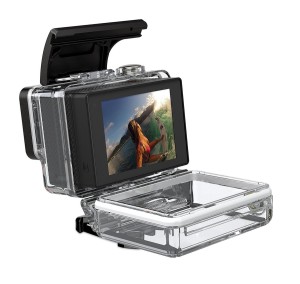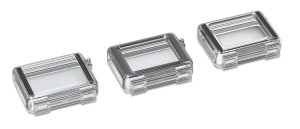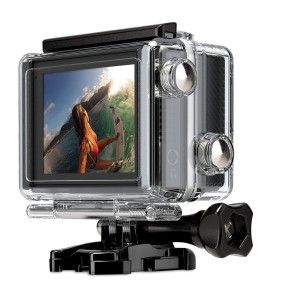GoPro LCD Touch BacPac
One of the key differentiating factors between the GoPro Hero 3+ and its direct competitors (particularly the JVC Adixxon 2 and the Drift Innovation Ghost S) is the GoPro’s lack of a built-in screen. While you can use wifi and the GoPro app to see live footage and review previously shot videos on a smartphone, this doesn’t really allow the GoPro to be used like a “normal” video camera, with the user continually viewing the image as it is captured and making adjustments. While this might not matter much or at all where the GoPro is to be mounted in a fixed position (and where you couldn’t see a screen anyway), it is more important where the intention is to use the GoPro like a more traditional camera and to control where it is pointed – as one might when scuba diving for example.
 GoPro have responded to this issue by releasing the GoPro Touch LCD BacPac. GoPro previously sold a detachable screen similar to this for the Hero 1 and 2 camera models, but this updated version for the Hero 3 and 3+ features, as the name suggests, a capacitive touchscreen., enabling the camera to be controlled via on-screen controls. The Touch BacPac comprises a colour LCD screen the same size as the back of the camera, which clips onto the rear face of the GoPro, hooking onto the rear right side and connecting via the port on the rear left side of the device. The BacPac features a single button on the right side, together with a small speaker and a 3.5mm headphone jack for use when playing back footage.
GoPro have responded to this issue by releasing the GoPro Touch LCD BacPac. GoPro previously sold a detachable screen similar to this for the Hero 1 and 2 camera models, but this updated version for the Hero 3 and 3+ features, as the name suggests, a capacitive touchscreen., enabling the camera to be controlled via on-screen controls. The Touch BacPac comprises a colour LCD screen the same size as the back of the camera, which clips onto the rear face of the GoPro, hooking onto the rear right side and connecting via the port on the rear left side of the device. The BacPac features a single button on the right side, together with a small speaker and a 3.5mm headphone jack for use when playing back footage.
 In the box with BacPac you get 6 new backdoors – 3 for use with your the current GoPro 3+ housing, and 3 that will fit the previous Hero 3 housing (which was slightly larger). In each case there are 3 ‘flavours’ of backdoor:
In the box with BacPac you get 6 new backdoors – 3 for use with your the current GoPro 3+ housing, and 3 that will fit the previous Hero 3 housing (which was slightly larger). In each case there are 3 ‘flavours’ of backdoor:
- The ‘Touch’ back door allows the capacitive touch inputs to be transferred to the screen through the door. However, the touch backdoor is only waterproof to a depth of 3m, and when used underwater the touch input will not work. As such, while it is ideal for protecting the GoPro from rain, snow and puddles when on dry land, and potentially use on the surface of the water (where you’re sure you won’t drop it!), it’s not really ideal for prolonged submersion, and obviously not at all for scuba diving.
- The ‘Standard’ backdoor, which is of a stronger construction and is waterproof to 131 feet (40m) like the standard GoPro case. The touch functionality of the BacPac does not work at all through this case, but it is still possible to access the various menu options through the use of the additional button mounted on the side of the BacPac in conjunction with the existing 2 buttons on the GoPro.
- The ‘Skeleton’ backdoor – like the original skeleton backdoor, this leaves the rear of the case effectively open, in order to improve the audio quality of the sound captured. However, since audio is not the GoPro’s strongest point in any event, in general it is arguably sensible to use one of the other two backdoors in order to project the camera unit against any moisture or dirt.
 In use, the Touch BacPac does add a further dimension to the GoPro’s functionality. The ability to immediately see what is in the field of view allows the GoPro to be used much more like a ‘real’ camera or video camera, and indeed on trips where space or weight is as a premium, a BacPac and a GoPro could potentially remove the need to carry a separate camera altogether. Perhaps as importantly, however, is the improvement in accessing the setup options for the GoPro. No longer is it necessary to scroll in one direction through the settings menu (usually having to to run through it all again at least once because you miss the option you want!) – instead, you can simply select the option you want on the touch screen. While the GoPro app on a wifi connected smartphone already provides this functionality, there are undoubtedly times when you do not want to be messing around with your (expensive, non-waterproof) phone when all you want to do is adjust the settings on the GoPro. The Touch BacPac makes this all much quicker and easier.
In use, the Touch BacPac does add a further dimension to the GoPro’s functionality. The ability to immediately see what is in the field of view allows the GoPro to be used much more like a ‘real’ camera or video camera, and indeed on trips where space or weight is as a premium, a BacPac and a GoPro could potentially remove the need to carry a separate camera altogether. Perhaps as importantly, however, is the improvement in accessing the setup options for the GoPro. No longer is it necessary to scroll in one direction through the settings menu (usually having to to run through it all again at least once because you miss the option you want!) – instead, you can simply select the option you want on the touch screen. While the GoPro app on a wifi connected smartphone already provides this functionality, there are undoubtedly times when you do not want to be messing around with your (expensive, non-waterproof) phone when all you want to do is adjust the settings on the GoPro. The Touch BacPac makes this all much quicker and easier.
Downsides? Clearly, the Touch BacPac increases the size of the GoPro housing, and as such can interfere with the mounting of the camera (for example, when used on a helmet front mount or ‘Chesty’ chest mount). However, as discussed above, since it’s unlikely that you would want to use the BacPac when the camera is mounted this way, this is isn’t a major issue.
The far bigger issue is that of battery life. The GoPro Hero 3+ cameras already have a relatively short battery life, with the most powerful Black model being the worst in this regard. As can be seen from the table below, the addition and use of the BacPac Touch screen tends to reduce the battery life by around 30 – 40%. It is however possible to turn the screen off so that it is only used where necessary. And, given that spare battery packs and charger units are now very affordable, it is not too big an issue to simply swap out an expired battery pack and continue your day’s shooting.
| Battery life at 1080p 30fps without Touch BacPac | Battery life at 1080p 30fps with Touch BacPac | |
|---|---|---|
| GoPro Hero 3+ Black | 2 hr 0 min | 1 hr 25 min |
| GoPro Hero 3+ Silver | 3 hr 0 min | 1 hr 50 min |
| GoPro Hero 3 White | 2 hr 15 min | 1 hr 30 min |
Overall, the GoPro Touch BacPac is a great accessory. It allows the GoPro to be much more than just a mounted action cam, and instead to become a properly usable lightweight, waterproof video camera. It also significantly improves the functionality of the camera and the speed with which the settings can be altered. If you ever use (or might plan to use) your GoPro while not in a fixed mount, and can cope with the reduced battery life, then in our view the Touch BacPac is well worth a purchase.
Click here to check out the latest price for the Touch BacPac!
